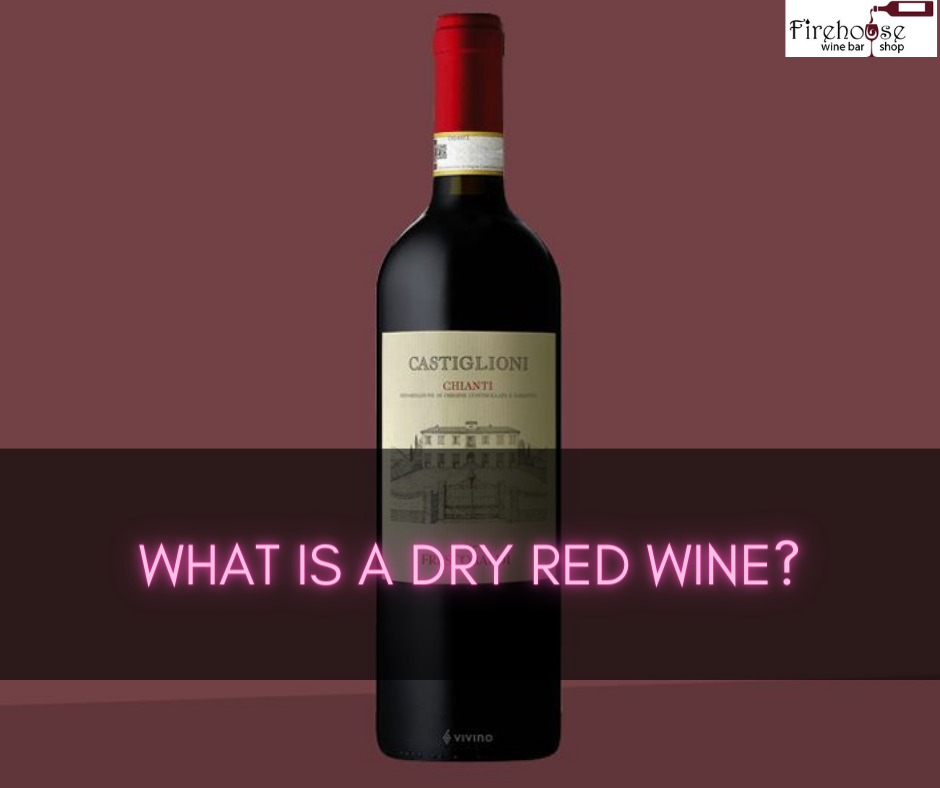Introduction: Understanding Dry Red Wine
What Is a Dry Red Wine? – Definition Of Dry Red Wine
When exploring the world of wines, one term you often hear is “dry red wine.” But What Is a Dry Red Wine? In simple terms, dry red wine is a type of wine with negligible residual sugar, resulting in a less sweet taste. The absence of sweetness in dry red wines allows the grapes’ natural flavors to shine through, showcasing the wine’s complexity and depth.
Differences Between Dry And Sweet Wines
Knowing the difference between dry and sweet wines is important to understand dry red wine better. Unlike sweet wines with a noticeable residual sugar level, dry wines undergo fermentation until most sugar is converted into alcohol. This process creates a drier taste profile and less perceived sweetness on the palate.
Many wine enthusiasts favor dry red wines due to their versatility and ability to pair well with various dishes. They are often characterized by their bold and robust flavors, ranging from fruity and jammy to earthy and spicy. Popular dry red wine varieties include Cabernet Sauvignon, Merlot, Pinot Noir, and Shiraz.
One must consider personal preferences and food pairings when selecting a dry red wine. Some people enjoy the tannic structure and rich flavors of full-bodied, dry red wines, while others prefer lighter, fruit-forward options. Pairing dry red wines with rich meats, aged cheeses, and hearty pasta dishes can enhance the dining experience.
In conclusion, understanding dry red wine is about recognizing its lack of sweetness and appreciating the intricate flavors it offers. Whether you’re a wine enthusiast or a casual drinker, exploring the world of dry red wines can open up many flavors and experiences. So, next time you’re searching for a wine to accompany your meal or to sip leisurely, consider exploring the diverse and captivating world of dry red wines.

Categories Of Dry Red Wine
When exploring ‘What Is a Dry Red Wine?’, it’s important to understand the various categories, ranging from off-dry to very dry. Each category offers a different sweetness and taste profile, allowing you to find the perfect dry red wine to suit your preferences. Let’s delve deeper into these categories.
Off-dry Red Wines
Off-dry red wines fall on the sweeter side of the dryness spectrum. While they still have a low residual sugar level, they may have a slightly perceptible sweetness. These wines can be a great option for those who prefer a hint of sweetness in their red wine. Examples of off-dry red wines include certain styles of Zinfandel, Grenache, and some Italian red varietals.
Very Dry Red Wines
We have very dry red wines on the other end of the spectrum. These wines have virtually no residual sugar, resulting in a completely dry taste profile. They are favored by those who enjoy bold and robust flavors with no hint of sweetness. Examples of very dry red wines include Cabernet Sauvignon, Syrah, Malbec, and certain styles of Pinot Noir.
When exploring the world of dry red wines, it’s important to note that the dryness level can vary within each category. Some wines may lean towards being slightly sweeter within the off-dry category, while others may exhibit a more pronounced dryness within the very dry category. This variation allows for various flavors and options to suit different palates.
When selecting a dry red wine, consider the food pairing you have in mind. If you’re enjoying a hearty meat dish or a cheese platter, a very dry red wine with its bold flavors and tannic structure can complement the richness of the food. On the other hand, if you prefer a subtle sweetness to balance the flavors of a lighter meal, an off-dry red wine can be a good choice.
In conclusion, navigating the world of dry red wine involves understanding the different categories and sweetness levels. From off-dry to very dry, each category offers a unique taste experience. Whether you prefer a hint of sweetness or a completely dry profile, there’s a dry red wine out there to suit your preferences. So, explore the diverse and captivating world of dry red wines and discover the flavors that resonate with you.
Factors Affecting Sweetness In Red Wine
When exploring ‘What Is a Dry Red Wine?’, it’s important to understand the factors contributing to the varying sweetness levels. One crucial factor is the fermentation process and residual sugar in the wine.
Fermentation Process And Residual Sugar
During fermentation, yeast converts the natural sugars in the grape juice into alcohol. The length of fermentation and the amount of sugar converted determine the level of residual sugar in the wine. More extended fermentation results in less residual sugar and a drier taste profile. On the other hand, shorter fermentation can leave more sugar in the wine, resulting in a sweeter taste.
Winemakers have control over the fermentation process and can influence the sweetness of the final product. They can halt fermentation earlier, leaving more residual sugar in the wine, or allow it to continue until there is virtually no sugar remaining, resulting in a dry wine.
Exceptions To Dry Red Wines
While dry red wines typically have little to no residual sugar, there are exceptions to this general rule. Some red wines may fall outside the dryness spectrum due to factors like grape variety, winemaking techniques, or regional preferences.
For example, certain styles of red Zinfandel and Grenache can have slightly perceptible sweetness, making them fall into the off-dry category. These wines balance dryness and sweetness, appealing to those who enjoy a hint of sweetness in their red wine.
It’s important to note that the dryness or sweetness level can also vary within each category of dry red wines. Some may lean towards being slightly sweeter within the off-dry category, while others may exhibit a more pronounced dryness within the very dry category. This variation allows for diverse flavors and options to suit different palates.
In conclusion, understanding the factors affecting sweetness in red wine is essential for navigating the world of dry red wine varieties. The fermentation process and the presence of residual sugar play a significant role in determining the sweetness level of the wine. While most dry red wines have minimal residual sugar, some exceptions exist, adding depth and variety to the category. Whether you prefer the bold and robust flavors of a very dry red wine or a hint of sweetness in an off-dry option, there is a red wine out there to suit your preferences. So, venture into the captivating world of red wine varieties and discover the flavors that resonate with you.

Sweetness Levels In Dry Red Wine
When exploring the world of red wine, understanding the sweetness levels can be crucial in finding the perfect bottle to suit your preferences. Red wine can range from sweet to dry, offering a diverse range of flavors and options to choose from. Here, we will delve into wine sweetness levels and provide some tips on researching sweetness levels in specific bottles.
Wine Sweetness Ranges
The sweetness level of red wine is primarily determined by the residual sugar left in the wine after the fermentation process. Dry red wines have minimal residual sugar, producing a crisp and less sweet taste. Conversely, sweet red wines have a higher residual sugar content, offering a richer and sweeter flavor profile.
There are variations in sweetness levels within the range of dry red wines. Some may lean towards being slightly sweeter within the off-dry category, while others exhibit a more pronounced dryness within the very dry category. This variation allows for diverse flavors that can cater to different palates.
Researching Sweetness Levels In Specific Bottles
When selecting a specific bottle of dry red wine, there are several ways to research its sweetness level. Here are some tips:
- Read the Description: Start by reading the wine description the winemaker or distributor provided. They often include information on the wine’s sweetness level, allowing you to gauge whether it falls within your desired range.
- Look for Wine Tasting Notes: Wine experts and enthusiasts often provide detailed tasting notes and reviews online. These notes can give you insights into the wine’s flavor profile, including its sweetness level.
- Check Wine Scores and Ratings: Wine scores and ratings by reputable sources can also provide valuable information. They often include descriptions that mention the wine’s sweetness level, helping you make an informed decision.
- Consult with Wine Professionals: If you’re unsure about a specific wine’s sweetness level, don’t hesitate to contact wine professionals at local wine shops or vineyards. They can offer personalized recommendations and guidance based on your preferences.
Remember, personal taste is subjective, and what may be considered sweet or dry to one person may vary for another. It’s always a good idea to try different wines and explore your palate to find the sweetness level that suits you best.
In conclusion, navigating the world of red wine varieties requires understanding sweetness levels. Dry red wines have minimal residual sugar, offering a less sweet taste, while sweet red wines have a higher sugar content for a richer flavor profile. Researching sweetness levels in specific bottles through descriptions, tasting notes, ratings, and consulting with wine professionals can help you find the perfect bottle that aligns with your taste preferences. So, dive into the captivating world of red wine and discover the delightful flavors that await you.
Regional Regulations And Guidelines
Regulations In The United States
In the United States, the Alcohol and Tobacco Tax and Trade Bureau (TTB) regulates the labeling and classification of wine. However, when it comes to sweetness levels, no specific regulations or guidelines define what constitutes a dry red wine. Instead, winemakers can determine the sweetness level of their wines based on their preferences and production techniques.
To help consumers understand the sweetness level of red wine, winemakers often use descriptive terms on the label. Terms like “dry,” “off-dry,” and “sweet” can provide a general indication of the wine’s sweetness. However, it’s important to note that these terms can vary in meaning between different wineries.
EU Standards For Dry Red Wine
In the European Union (EU), strict regulations govern the labeling and classification of wines, including dry red wines. According to EU standards, a wine labeled as “dry” must contain no more than 4 grams of residual sugar per liter.
These regulations ensure consistency and clarity for consumers when determining the sweetness level of a red wine. However, it’s important to consider that individual winemakers may still have some flexibility in interpreting and applying these guidelines.
It’s worth noting that while the United States and the EU have different regulatory approaches to defining sweetness levels in red wine, wine professionals and enthusiasts often rely on their own tasting experiences and knowledge to determine the sweetness level of a specific bottle. Tasting notes, descriptions, and reviews can provide valuable insights into a wine’s flavor profile and sweetness.
Ultimately, the best way to navigate the world of red wine varieties and understand their sweetness levels is through personal exploration and experimentation. Every person’s palate is unique, and what may be considered dry or sweet can vary from one individual to another.
As you embark on your red wine journey, don’t be afraid to try different bottles, consult with experts, and discover the flavors that appeal to your taste preferences. Whether you prefer a crisp and dry red or a rich and sweet one, the world of red wine offers something for every wine lover.

Popular Types And Styles Of Dry Red Wine
When navigating the world of red wine varieties, understanding the sweetness levels can be key in finding the perfect wine to suit your taste preferences. While no specific regulations or guidelines define what constitutes a dry red wine, some popular types and styles generally fall into the drier spectrum.
Wine Varieties With Similar Sweetness Levels
Several red wine varieties are typically known for their dryness. These include:
- Cabernet Sauvignon: Known for its bold and full-bodied flavor, Cabernet Sauvignon is often associated with dryness. It pairs well with red meat and has a relatively low sugar content.
- Merlot: Merlot is another popular dry red wine variety. It is often described as smooth and velvety, with less tannin than Cabernet Sauvignon.
- Pinot Noir: Pinot Noir is a versatile red wine ranging from light to medium-bodied. It typically has a dry and fruity taste profile.
- Syrah/Shiraz: Syrah or Shiraz wines are known for their robust flavors and dryness. They often display notes of dark fruits, pepper, and spices.
These red wine varieties offer a range of flavors and characteristics while maintaining a predominantly dry profile.
Rare And Special Cases Of Exceptional Sweetness
While dry red wines are more commonplace, there are some rare and special cases where red wines can exhibit exceptional sweetness. These include:
- Late Harvest: Late harvest wines are made from grapes left on the vine for longer, allowing them to accumulate more sugar. These wines can have a higher sweetness level and are often dessert wines.
- Amarone: Amarone is an Italian red wine made from partially dried grapes. This production method concentrates the sugar content, producing a wine with a higher residual sugar level.
- Port: Port is a fortified wine from Portugal, known for its rich, sweet flavors. It is often enjoyed as a dessert wine or paired with cheese.
These exceptional cases offer unique tasting experiences and are ideal for those who prefer sweeter red wines or for special occasions.
Navigating the world of red wine varieties is a personal journey guided by your taste preferences. Understanding the general sweetness levels of popular red wine types can provide a helpful starting point in finding the perfect dry red wine that suits your palate. Whether you prefer Cabernet Sauvignon’s boldness, Merlot’s smoothness, or Pinot Noir’s versatility, there is a dry red wine out there waiting to be discovered and enjoyed.
Conclusion
Now you should know the answer to ‘What Is a Dry Red Wine?’. Understanding the sweetness levels of red wine varieties is essential in finding the perfect wine to suit your taste preferences. While there are no specific regulations or guidelines for defining what constitutes a dry red wine, there are popular types and styles that generally fall into the drier spectrum.
Summary of Dry Red Wine Varieties and Sweetness Levels
Some red wine varieties are typically known for their dryness. With its bold and full-bodied flavor, Cabernet Sauvignon pairs well with red meat and has a relatively low sugar content. Merlot, on the other hand, is smooth and velvety with less tannin compared to Cabernet Sauvignon. Pinot Noir is a versatile red wine that can be light to medium-bodied and typically has a dry and fruity taste profile. Syrah or Shiraz wines are robust and dry with notes of dark fruits, pepper, and spices.
While dry red wines are more common, there are rare and special cases where red wines exhibit exceptional sweetness. Late-harvest wines, made from grapes left on the vine longer to accumulate more sugar, offer a higher sweetness level and are often enjoyed as dessert wines. Amarone, an Italian red wine made from partially dried grapes, has a higher residual sugar level. Port, a fortified wine from Portugal, is known for its rich and sweet flavors, often enjoyed as a dessert wine or paired with cheese.
Tips for Finding Your Preferred Dry Red Wine
Navigating the world of red wine varieties can be a personal journey guided by your taste preferences. Here are some tips for finding your preferred dry red wine:
- Experiment: Try different varieties with different flavor profiles and sweetness levels to discover what resonates with your palate.
- Consider Food Pairings: Different dry red wines complement different types of food—experiment with pairing them to enhance your dining experience.
- Seek Recommendations: Don’t be afraid to ask sommeliers or wine enthusiasts for suggestions based on your preferences. They can provide valuable insights and guidance.
- Explore Wine Regions: Different regions have specialties and unique red wine varieties. Explore wines from different regions to expand your knowledge and experience.
- Keep a Tasting Journal: Keep track of the dry red wines you try and note your thoughts and preferences. This can help you remember which wines you enjoyed and provide a reference for future selections.
With these tips in mind, you’ll be well on your way to navigating the world of red wine varieties and finding the preferred dry red wine that suits your palate. Cheers to enjoyable wine-tasting experiences!
FAQ: What Is a Dry Red Wine – From Sweet to Dry: Navigating the World of Red Wine Varieties
Q: What is a dry red wine?
A: A dry red wine is a type of red wine that contains little to no sugar. It is the opposite of sweet wines with a higher sugar content. Dry red wines are known for their complexity of flavors without the distraction of sweetness.
Q: Are all red wines dry?
A: Yes, almost all red wines are considered dry. However, certain producers may include residual sugar in their wines to cater to specific customer preferences.
Q: What are some classic food pairings for dry red wines?
A: Some classic food pairings for dry red wines include:
- Sangiovese with pasta in a red sauce
- Napa Valley Cabernet Sauvignon with grilled steak
- Pinot Noir with seared salmon or lamb
- Northern Rhone wines with duck
Q: What are the types of dry red wines?
A: There are various types of dry red wines available. Some popular ones include:
- Cabernet Franc: Lighter in body and tannins, with brighter red fruit and herbal flavors.
- Cabernet Sauvignon: Bold and intense, often paired with grilled meats.
- Pinot Noir: A versatile varietal known for its fruity and earthy characteristics.
Q: How much sugar can a dry red wine have?
A: In the United States, no specific laws dictate how much sugar a dry red wine may contain. However, in the European Union, a dry wine may have up to nine grams of sugar per liter. In practice, most dry wines tend to contain much less sugar.
Q: Can you recommend other dry red wine varietals to explore?
A: Once you have developed your palate for dry red wines, you can explore other varietals and blends made in a dry style. This allows you to expand your horizons and discover new aromas and flavors within different grape varieties and regions.

Andre Lotz immigrated to the United States from South Africa almost 20 years ago. Still, he didn’t feel truly at home until he settled in Mobile—a city that reminds him of his childhood home of Fish Hoek on the southern cape of Africa.

